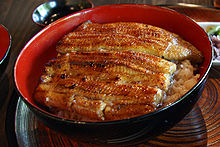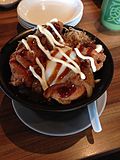Donburi: Difference between revisions
Improved the image |
|||
| (17 intermediate revisions by 13 users not shown) | |||
| Line 9: | Line 9: | ||
The simmering sauce varies according to season, ingredients, region, and taste. A typical sauce might consist of ''[[dashi]]'' (stock broth) flavored with [[soy sauce]] and ''[[mirin]]'' (rice wine). Proportions vary, but there is normally three to four times as much ''dashi'' as soy sauce and ''mirin''. For ''[[oyakodon]]'', Tsuji (1980) recommends dashi flavored with light soy sauce, dark soy sauce, and sugar. For ''[[gyūdon]]'', Tsuji recommends water flavored with dark soy sauce and ''mirin''. |
The simmering sauce varies according to season, ingredients, region, and taste. A typical sauce might consist of ''[[dashi]]'' (stock broth) flavored with [[soy sauce]] and ''[[mirin]]'' (rice wine). Proportions vary, but there is normally three to four times as much ''dashi'' as soy sauce and ''mirin''. For ''[[oyakodon]]'', Tsuji (1980) recommends dashi flavored with light soy sauce, dark soy sauce, and sugar. For ''[[gyūdon]]'', Tsuji recommends water flavored with dark soy sauce and ''mirin''. |
||
Donburi can be made from almost any ingredients, including leftovers. |
|||
==Varieties of donburi== |
==Varieties of donburi== |
||
| Line 17: | Line 17: | ||
{{Main|Gyūdon}} |
{{Main|Gyūdon}} |
||
[[File:Gyudon by jetalone in Higashi-Ginza, Tokyo.jpg|thumb|''Gyūdon'' beef bowl]] |
[[File:Gyudon by jetalone in Higashi-Ginza, Tokyo.jpg|thumb|''Gyūdon'' beef bowl]] |
||
{{Nihongo|''Gyūdon''|{{linktext|牛丼}}|extra=literally 'beef bowl'}}, is a Japanese dish consisting of a bowl of rice topped with beef and onion simmered in a mildly sweet sauce flavored with ''dashi'' (fish and seaweed stock), soy sauce and ''mirin'' (sweet rice wine). It also often includes [[shirataki noodles]], and is sometimes topped with a raw egg or a soft poached egg (''onsen tamago''). |
{{Nihongo|''Gyūdon''|{{linktext|牛丼}}|extra=literally 'beef bowl'}}, is a Japanese dish consisting of a bowl of rice topped with beef and onion simmered in a mildly sweet sauce flavored with ''dashi'' (fish and seaweed stock), soy sauce and ''mirin'' (sweet rice wine). It also often includes [[shirataki noodles]], and is sometimes topped with a raw egg or a soft poached egg (''[[onsen tamago]]''). |
||
===''Butadon''=== |
===''Butadon''=== |
||
[[File:Pork bowl of Sukiya.jpg|thumb|Butadon]] |
|||
''Buta'' means pork. {{Nihongo|"''Butadon''"|{{linktext|豚|丼}}}} is a dish made with pork instead of beef in a mildly sweet sauce. ''Butadon'' originated in [[Hokkaido]] but is now enjoyed all over Japan.<ref name="auto">{{Cite web |url=http://wasa-bi.com/topics/332 |title= |
''Buta'' means pork. {{Nihongo|"''Butadon''"|{{linktext|豚|丼}}}} is a dish made with pork instead of beef in a mildly sweet sauce. ''Butadon'' originated in [[Hokkaido]] but is now enjoyed all over Japan.<ref name="auto">{{Cite web |url=http://wasa-bi.com/topics/332 |title=10 Best "DONBURI" in Japanese Food You Must Try! | Wasabi - Japanese Culture Media |access-date=2015-10-18 |archive-url=https://web.archive.org/web/20151020124752/http://wasa-bi.com/topics/332 |archive-date=2015-10-20 |url-status=dead }}</ref> |
||
==={{anchor|Tendon}}''Tendon''=== |
==={{anchor|Tendon}}''Tendon''=== |
||
| Line 32: | Line 33: | ||
===''Unadon''=== |
===''Unadon''=== |
||
{{Main|Unadon}} |
{{Main|Unadon}} |
||
[[File:Unadon (15664670489).jpg|thumb|Unadon]] |
|||
{{Nihongo|''Unadon''|{{linktext|鰻|丼}}|extra=an abbreviation for unagi + donburi, "eel bowl"}} is a dish originating in Japan. It consists of a ''donburi'' type large bowl filled with steamed white rice, and topped with fillets of eel (unagi) grilled in a style known as kabayaki, similar to teriyaki. The fillets are glazed with a sweetened soy-based sauce, called ''tare'' and caramelized, preferably over charcoal fire. The fillets are not flayed, and the grayish skin side is placed |
{{Nihongo|''Unadon''|{{linktext|鰻|丼}}|extra=an abbreviation for unagi + donburi, "eel bowl"}} is a dish originating in Japan. It consists of a ''donburi'' type large bowl filled with steamed white rice, and topped with fillets of eel (unagi) grilled in a style known as kabayaki, similar to teriyaki. The fillets are glazed with a sweetened soy-based sauce, called ''tare'' and caramelized, preferably over charcoal fire. The fillets are not flayed, and the grayish skin side is placed face-down. ''Una-don'' was the first type of ''donburi'' rice dish, invented in the late [[Edo period]], during the [[Bunka]] era (1804–1818) |
||
===''Tamagodon''=== |
===''Tamagodon''=== |
||
| Line 40: | Line 42: | ||
{{Main|Oyakodon}} |
{{Main|Oyakodon}} |
||
[[File:Oyakodon 003.jpg|thumb|''Oyakodon'']] |
[[File:Oyakodon 003.jpg|thumb|''Oyakodon'']] |
||
{{Nihongo|''Oyakodon''|{{linktext|親子|丼}}}} consists of [[simmering|simmered]] [[chicken]], [[egg]], and sliced [[scallion]] served on top of a large bowl of rice. The chicken is also sometimes replaced with [[beef]] or [[pork]] in a variation referred to as {{nihongo|''Tanindon''|{{linktext|他人}}丼}}. |
{{Nihongo|''Oyakodon''|{{linktext|親子|丼}}}} consists of [[simmering|simmered]] [[Chicken as food|chicken]], [[Eggs as food|egg]], and sliced [[scallion]] served on top of a large bowl of rice. The chicken is also sometimes replaced with [[beef]] or [[pork]] in a variation referred to as {{nihongo|''Tanindon''|{{linktext|他人}}丼}}. |
||
===''Katsudon''=== |
===''Katsudon''=== |
||
| Line 54: | Line 56: | ||
==={{anchor|Karēdon}} ''Karēdon''=== |
==={{anchor|Karēdon}} ''Karēdon''=== |
||
{{Nihongo|''Karēdon''|{{linktext|カレー|丼}}}} consists of thickened curry |
{{Nihongo|''Karēdon''|{{linktext|カレー|丼}}}} consists of thickened curry-flavored ''[[dashi]]'' on rice. It was derived from curry ''[[udon]]'' or curry ''nanban'' (a ''soba'' dish). Sold at ''soba/udon'' restaurants. |
||
===''Tekkadon''=== |
===''Tekkadon''=== |
||
[[File:大洗町の大人気店『悠久』.jpg|thumb|Tuna bowl served at a very popular restaurant in [[Ōarai, Ibaraki|Oarai Japan]]]] |
|||
{{Main|Tekkadon}} |
{{Main|Tekkadon}} |
||
{{Nihongo|''Tekkadon''|{{linktext|鉄|火|丼}}}} consists of thinly-sliced raw [[tuna]] on rice. Spicy tekkadon is made with what can be a mix of spicy ingredients, a spicy orange sauce, or both (usually incorporates spring onions). |
{{Nihongo|''Tekkadon''|{{linktext|鉄|火|丼}}}} consists of thinly-sliced raw [[Tuna as food|tuna]] on rice. Spicy tekkadon is made with what can be a mix of spicy ingredients, a spicy orange sauce, or both (usually incorporates spring onions). |
||
===''Hokkaidon''=== |
===''Hokkaidon''=== |
||
| Line 64: | Line 67: | ||
===''Negitorodon''=== |
===''Negitorodon''=== |
||
{{Nihongo|''Negitorodon''|{{linktext|ネギ}}トロ丼}} consists of diced ''[[List of sushi and sashimi ingredients#Seafood|toro]]'' (fatty tuna) and [[Allium fistulosum|negi]] (spring onions) on rice. |
{{Nihongo|''Negitorodon''|{{linktext|ネギ}}トロ丼}} consists of [[negitoro]], aka diced ''[[List of sushi and sashimi ingredients#Seafood|toro]]'' (fatty tuna) and [[Allium fistulosum|negi]] (spring onions) on rice. |
||
===''Ikuradon''=== |
===''Ikuradon''=== |
||
[[File:Ikura don.jpg|thumb|Ikura don]] |
|||
{{Nihongo|''Ikuradon''|いくら丼}} is seasoned ''ikura'' (salmon roe) on rice. |
{{Nihongo|''Ikuradon''|いくら丼}} is seasoned ''ikura'' (salmon roe) on rice. |
||
| Line 73: | Line 77: | ||
{{Nihongo|''Kaisendon''|{{linktext|海鮮|丼}}}} consists of thinly-sliced [[sashimi]] on rice. Fish roe may also be included. |
{{Nihongo|''Kaisendon''|{{linktext|海鮮|丼}}}} consists of thinly-sliced [[sashimi]] on rice. Fish roe may also be included. |
||
===''Tenshindon'' or '' |
===''Tenshindon'' or ''tenshin-han''=== |
||
{{Main|Tenshindon}} |
{{Main|Tenshindon}} |
||
{{Nihongo|''Tenshindon'' or '' |
{{Nihongo|''Tenshindon'' or ''tenshin-han''|{{linktext|天津|丼}} / 天津{{linktext|飯}}}} is a Chinese-Japanese specialty, consisting of a crabmeat [[omelet]] on rice; this dish is named for the city of [[Tianjin]]. |
||
===''Chūkadon''=== |
===''Chūkadon''=== |
||
{{Main|Chūkadon}} |
{{Main|Chūkadon}} |
||
[[File:Chukadon of Hidakaya (1).jpg|thumb|Chūkadon]] |
|||
{{Nihongo|''Chūkadon''|{{linktext|中華|丼}}|extra=literally "[[Names of China|Chinese]] rice bowl"}} consists of a bowl of rice with stir-fried vegetables, onions, mushrooms, and thin slices of meat on top. This dish is similar to [[ |
{{Nihongo|''Chūkadon''|{{linktext|中華|丼}}|extra=literally "[[Names of China|Chinese]] rice bowl"}} consists of a bowl of rice with stir-fried vegetables, onions, mushrooms, and thin slices of meat on top. This dish is similar to [[chop suey]], and is sold at inexpensive [[Japanese Chinese cuisine|Chinese restaurants in Japan]]. |
||
==Gallery== |
==Gallery== |
||
Latest revision as of 12:05, 9 May 2024
This article includes a list of general references, but it lacks sufficient corresponding inline citations. (August 2019) |

Donburi (丼, literally "bowl", also abbreviated to "-don" as a suffix, less commonly spelled "domburi") is a Japanese "rice-bowl dish" consisting of fish, meat, vegetables or other ingredients simmered together and served over rice. Donburi meals are usually served in oversized rice bowls which are also called donburi. If one needs to distinguish, the bowl is called donburi-bachi (丼鉢) and the food is called donburi-mono (丼物).
The simmering sauce varies according to season, ingredients, region, and taste. A typical sauce might consist of dashi (stock broth) flavored with soy sauce and mirin (rice wine). Proportions vary, but there is normally three to four times as much dashi as soy sauce and mirin. For oyakodon, Tsuji (1980) recommends dashi flavored with light soy sauce, dark soy sauce, and sugar. For gyūdon, Tsuji recommends water flavored with dark soy sauce and mirin.
Donburi can be made from almost any ingredients, including leftovers.
Varieties of donburi[edit]
Traditional Japanese donburi include the following:
Gyūdon[edit]

Gyūdon (牛丼, literally 'beef bowl'), is a Japanese dish consisting of a bowl of rice topped with beef and onion simmered in a mildly sweet sauce flavored with dashi (fish and seaweed stock), soy sauce and mirin (sweet rice wine). It also often includes shirataki noodles, and is sometimes topped with a raw egg or a soft poached egg (onsen tamago).
Butadon[edit]

Buta means pork. "Butadon" (豚丼) is a dish made with pork instead of beef in a mildly sweet sauce. Butadon originated in Hokkaido but is now enjoyed all over Japan.[1]
Tendon[edit]

Tendon (天丼) consists of tempura on a bowl of rice. The name "tendon" is an abbreviation of tempura (天ぷら or 天麩羅) and donburi (丼).
Tentamadon[edit]
Tentamadon (天玉丼) consists of tempura which is simmered with beaten egg and topped on rice.
Unadon[edit]

Unadon (鰻丼, an abbreviation for unagi + donburi, "eel bowl") is a dish originating in Japan. It consists of a donburi type large bowl filled with steamed white rice, and topped with fillets of eel (unagi) grilled in a style known as kabayaki, similar to teriyaki. The fillets are glazed with a sweetened soy-based sauce, called tare and caramelized, preferably over charcoal fire. The fillets are not flayed, and the grayish skin side is placed face-down. Una-don was the first type of donburi rice dish, invented in the late Edo period, during the Bunka era (1804–1818)
Tamagodon[edit]
Tamagodon (玉子丼) consists of a scrambled egg mixed with sweet donburi sauce on rice.
Oyakodon[edit]

Oyakodon (親子丼) consists of simmered chicken, egg, and sliced scallion served on top of a large bowl of rice. The chicken is also sometimes replaced with beef or pork in a variation referred to as Tanindon (他人丼).
Katsudon[edit]

Katsudon (カツ丼) consists of breaded deep-fried pork cutlets (tonkatsu) and onion are simmered and binding by beaten egg, then topped on rice. There are some regional variations in Japan.
Sōsukatsudon[edit]
Sōsukatsudon (ソースカツ丼) is similar to Katsudon, but with sliced cabbage and sweet-salty sauce instead of egg.[1]
Konohadon[edit]
Konohadon (木の葉丼) is similar to oyakodon, but using thin sliced kamaboko pieces instead of chicken meat. Popular in Kansai area.
Karēdon[edit]
Karēdon (カレー丼) consists of thickened curry-flavored dashi on rice. It was derived from curry udon or curry nanban (a soba dish). Sold at soba/udon restaurants.
Tekkadon[edit]

Tekkadon (鉄火丼) consists of thinly-sliced raw tuna on rice. Spicy tekkadon is made with what can be a mix of spicy ingredients, a spicy orange sauce, or both (usually incorporates spring onions).
Hokkaidon[edit]
Hokkaidon (北海丼) consists of thinly-sliced raw salmon over rice.
Negitorodon[edit]
Negitorodon (ネギトロ丼) consists of negitoro, aka diced toro (fatty tuna) and negi (spring onions) on rice.
Ikuradon[edit]

Ikuradon (いくら丼) is seasoned ikura (salmon roe) on rice.
Kaisendon[edit]

Kaisendon (海鮮丼) consists of thinly-sliced sashimi on rice. Fish roe may also be included.
Tenshindon or tenshin-han[edit]
Tenshindon or tenshin-han (天津丼 / 天津飯) is a Chinese-Japanese specialty, consisting of a crabmeat omelet on rice; this dish is named for the city of Tianjin.
Chūkadon[edit]

Chūkadon (中華丼, literally "Chinese rice bowl") consists of a bowl of rice with stir-fried vegetables, onions, mushrooms, and thin slices of meat on top. This dish is similar to chop suey, and is sold at inexpensive Chinese restaurants in Japan.
Gallery[edit]
-
Pork sukiyakidon
-
Kaisendon
-
A bowl of Japanese rice topped with karaage chicken, soft-boiled egg, vegetables and topped with condiments
See also[edit]
- Gaifan - similar Chinese dish
- Loco moco - similar Hawaiian dish
- Japanese cuisine
- List of Japanese dishes
References[edit]
- ^ a b "10 Best "DONBURI" in Japanese Food You Must Try! | Wasabi - Japanese Culture Media". Archived from the original on 2015-10-20. Retrieved 2015-10-18.
Bibliography[edit]
- Tsuji, Shizuo (1980). Japanese cooking: A simple art. New York: Kodansha International/USA. ISBN 0-87011-399-2.



